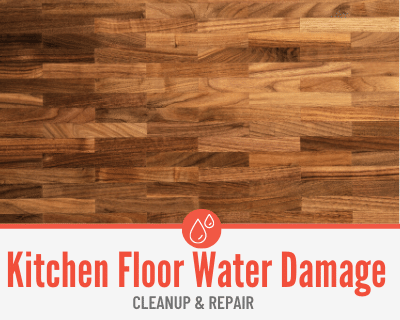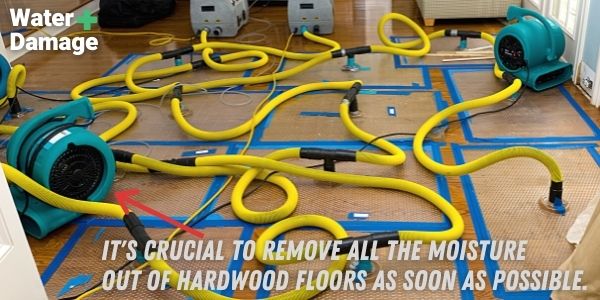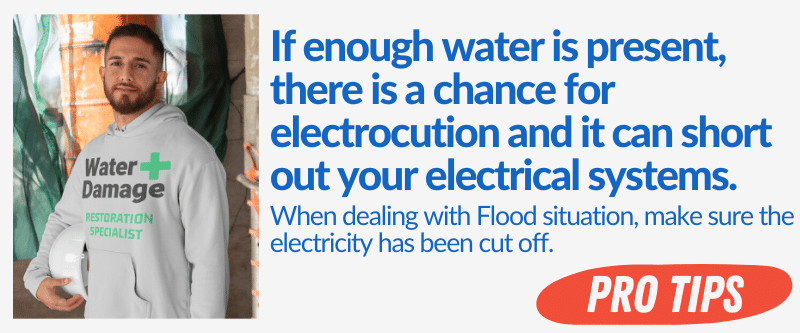So, you have water on your kitchen floor? If so, it is important to understand the source of the water and then the type of kitchen flooring you have.
In this article we will help you understand both: different kinds of flooring and common sources of leaks in the kitchen.
We will also offer multiple suggestions on how to address each issue and how to deal with Kitchen Floor that is Flood Damaged.

How Serious Is Flooded Kitchen Floor?
Spilling a glass of water in your kitchen is not a huge problem. The spill if addressed quickly and efficiently causes little or no real damage to your kitchen floors.
But flooding (and other potential large leak issues) can happen in your kitchen, and they in turn can become serious problems.
Before we address the water issue lets quickly review some of the more common types of kitchen flooring and their strengths and resistance to water.
Hardwood floors
Hardwood is fairly durable when it comes to water resistance. It can withstand light spills for a short amount of time while looking beautiful in the home.
In wort case in flood situation if water is removed quickly it can be re-finished without having to completely replace it
Hardwood is also generally pretty study and resistant to the regular wear and tear of ownership while being easy to clean.
While some hardwood might be water resistant, it is not waterproof and excessive water and moisture can damage the floor over time.
Laminate floors
Laminate is a cheaper option of flooring that can easily be installed by the homeowner. It is a thinner and lighter flooring that often gives the appearance of a hardwood look but does not have the same durability when it comes to water resistance.
Like hardwood, laminate is not waterproof. Excessive water and moisture build up will damage the laminate flooring almost instantly.
Tile floors
Tile is a hard and durable flooring option. If installed properly a good tile can be extremely durable to water and moisture build up.
Tile is one of the most popular options on the market for kitchen floors.
Tile is not immune to any water damage, and we will discuss how to treat kitchen floor tile in the event of serious water damage below.
Flooded Kitchen Floor?
Call 844-488-0570 for a Risk Free estimate from a Licensed Water Damage Mitigation and Restoration Specialist in your area.
We Can Help Dry out Your Kitchen Floor and Repair it In case of Flood Damage.
How do you dry a flooded kitchen floor and repair the damage?
Outside of a basic spill in the kitchen, excessive water build up can cause your flooring serious issues.
As mentioned above none of the more common types of tiling in the kitchen are 100% waterproof and resistant.
Laminate Floor Water / Flood Damage
Signs you may have issues after flood or water damage with your laminate include but are not limited to bubbling, cupping, cracking, splitting, buckling, mold and often more.
Discoloration is also a sign of water damage.
Steps to take to address water and your laminate flooring:
- Contain the water damage (we will discuss later in the article below)
- Use a shop vac or water vac to soak up all the water. Remove all water even in hidden or tiny spots.
- Remove the damaged planks and throw them away.
- Check your sub flooring and address any moisture and wetness by drying.
- Soaking up the water, using a fan to help air flow and drying, and use of a dehumidifier are all good steps.
- Begin to replace your damaged planks with new, replacement ones.
Read the Full Guide Here: Repairing Laminate Floor Water Damage
Tile Floor Water/Flood Damage
Tile floors generally holds up very well to water, moisture, and water damage but a common sign that your tile has water damage is erosion within the grout and water coming up from underneath the tile.
Steps to take and address your tile floor include:
- Contain the damage (we will discuss later in the article below)
- Clean up the leak with a shop vac or water vac.
- Consider using fans and dehumidifiers to dry out the room.
- If water has got under the tile, Remove the tile to access the subfloor. Dry the sub floor.
- Disinfect against any mold or mildew.
- Replace the tile and seal.
Hardwood floors
Water will often get in between the hardwood floorboards and reach the sub floor.
Some signs your hardwood floors have water damage are warping, buckling, cracking, splitting, or staining.
Steps to take with your hardwood floors:
- Contain the source of the flood water.
- Collect the Water, if there is large amounts of water consider calling a water damage restoration company as It’s crucial to remove the water from hardwood floors as soon as possible.
- Dry the Flooring, If water has penetrated the hardwood floors, it’s crucial to dry them out properly with a dehumidifier to avoid cupping/staining/warping.
- if some planks are damaged, Identify planks to be removed and remove planks.
- Dry and disinfect your subfloor if needed.
- Replace planks.
- Sand, stain and re-finish newer planks once you have installed them.

sub floor Water Damage after Flood
Addressing the sub floor after a flood or spill can be a tricky issue. If you can clean up and address the spill on the subfloor in a basic manner then you are encouraged to do just that.
Basic steps for addressing the sub floor would include containing the water, use of a broom or a shop vac to get rid of the water, dis infect after you are sure moisture has been eliminated (to combat mold/mildew) and then begin to re-apply your flooring surface.
Using a dehumidifier is helpful because it will reduce the moisture on the subfloor.
Read our Guide: Wet Subfloor Drying
If these steps are not adequate and you feel the issue is larger one you may need to contact a professional.
For instance, if you need to remove infected parts of the sub floor with a saw or other tool then this may be a good time to gain professional guidance.
Why is my kitchen floor flooding?
In the previous section we talked about ‘containing the flood or source of water.’ Below we list some of the more common issues that are found with regards to kitchen flooding and leaks.
Check your Sink.
A clogged sink can cause water to leak on your kitchen floor. Over time food, grease, and grime build up will cause various clogs in the pipes at different levels.
You may need to use and purchase a snake to work down deep into the drain so you can unclog food or items wedged inches down the pipe.
Check your Refrigerator.
Small leaks on the floor maybe issues coming from your refrigerator. You can check and see if you can find the culprit of the leak.
This can be as simple as making sure any food items or ice are not blocking the defrost drain in your freezer. Additionally, you should also check your water supply line for issues if you have water leaking underneath the fridge.
Another small issue could be the level of your fridge. This can cause condensation issues. You want to make sure the fridge is tilted to where the front is slightly higher than the back.
Check your faucet (leaky faucet).
If you have water leaking from the base of your faucet a good place to start would be to check the O ring seal and make sure it is not eroded.
If you need a replacement, take caution to make sure that you use the correct size that corresponds with your faucet.
Other faulty mechanics may be an issue with your leaky faucet as well.
A stem washer, located above the O ring, maybe faulty and needing replacement.
You may need a new valve cartridge, located under the handle on your sink, if your faucet is leaking.
If you have multiple issues with faulty equipment and different pieces, then it is suggested that you contact a professional because the project might be too large for you to take on by yourself.
Check your dishwasher for leaks.
Many different issues can arise as problems with your dishwasher.
Some of these can be simple fixes without any major actions.
The goal is that you do not have to remove your entire dishwasher.
Some of the common issues are a bad switch causing running water to come from the dishwasher. Additionally, broken gaskets and other connection pieces can cause water to come from your dishwasher.
Check your garbage disposal.
Often something small, like a kernel of popcorn, will clog your disposal and cause water issues that can affect your floor. Cleaning out the disposal and removing small items will normally resolve a disposal issue.
You can also use an Allen wrench and reset the disposal from underneath your sink.

Water Coming up through Kitchen Floor.
Another water issue outside of those listed above, is water coming up through the flooring. A small crack in the concrete foundation below your flooring can cause water to enter your kitchen. If this is the case, then you can use a compound patching agent from the store and follow instructions on the bag.
If you do not have a crack in the cement that you can see, the issue maybe best addressed by contacting a plumber. A plumber will be able to detect the source of the floor or leak and recommend next steps.
A broken pipe underneath your kitchen floor would be a major fix best addressed by a professional.
Another common issue (and typically an inexpensive fix) would be that you need to have your sump pump drained.
Again, a professional would be able to diagnose why you have the leak and recommend the next best step.
Kitchen Sink Cabinet Floor Replacement
Cabinets are in a bad spot and will at times incur lots of water damage in the kitchen. Some basic steps to deal with water damaged kitchen cabinets are listed below:
- Contain water flow or source near the cabinets.
- Remove all cabinet doors and empty out your cabinets.
- Survey the extent of the damage all throughout your cabinets and make sure you address hidden spaces.
- Dry the areas that are wet with a towel or shop vac.
- Create air flow to combat mold using a fan or any other drying agent.
- Put a de humidifier in the kitchen to decrease the moisture build up.
- Apply an anti-bacterial to prevent the growth of any mold or mildew on and near the cabinets.
When to Call a Professional?
- You have a lot of water to remove, if not done in time this can soak up the subfloor and cause serious subfloor issues and mold to grow and spread.
- There is a lot of moisture in your floor, this needs to be usually dried with industrial-grade equipment and dehumidifiers so it does not damage your flooring.
- You might have a broken pipe under the flooring. This is likely a major issue that only a trained professional can address because it would entail operating at a level underneath the concrete of your flooring to fix the issue.
- You might have a large foundational issue underneath the flooring that needs to get immediately fixed so the problem does not compound itself.
We have Water Damage Restoration Technicians that can help Dry out and Restore your Flooring
For Disasters of all Sizes, available in 95% of the USA!
